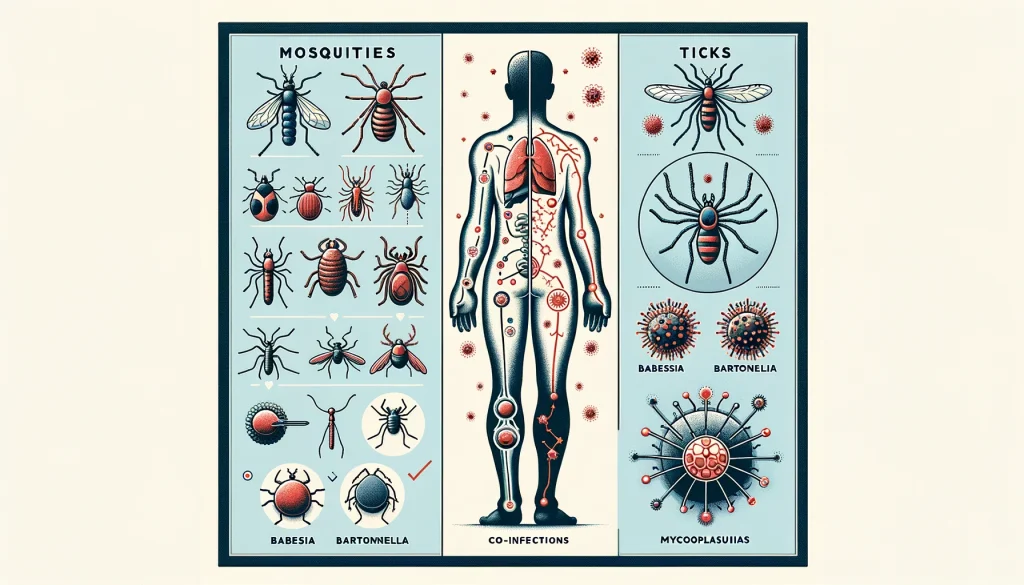This week we are talking about Vector-Borne Illnesses



Unraveling Vector-Borne Illnesses and Tic Disorders
Are you a caring parent, worried sick about your child’s sudden behavioral changes or tic symptoms? You’re not alone! Many parents find themselves lost in the maze of tic disorders, seeking answers and natural solutions. But what if the culprit behind your child’s struggles is tinier than you ever imagined – a sneaky vector-borne illness? Let’s put on our detective hats and unravel this!
The Mighty Vectors and Their Tiny Weapons
First off, let’s get to know our suspects: vector-borne illnesses. These crafty conditions are transmitted by the bite of infected critters like mosquitoes, ticks, and fleas. The most notorious one? Lyme disease. But Lyme isn’t a lone wolf – it often comes with an entourage of co-infections like Babesia, Bartonella, and Mycoplasma. Talk about a party you don’t want an invite to!
PANS, PANDAS, and the Immune System Mayhem
Now, let’s see how these microscopic menaces can wreak havoc on your kiddo’s health. Ever heard of PANS (Pediatric Acute-onset Neuropsychiatric Syndrome) or PANDAS (Pediatric Autoimmune Neuropsychiatric Disorders Associated with Streptococcal Infections)? These tongue twisters mean that infections or environmental triggers can send your child’s immune system into a frenzy, leading to symptoms like tics, OCD, mood swings, and anxiety. It’s like their body’s defenses are playing a chaotic game of “tag, you’re it!” with their own tissues.
Connecting the Dots: Vector-Borne Illnesses and Tic Disorders
So, how do vector-borne illnesses fit into this puzzle? Studies suggest that sneaky infections like Lyme disease can be the spark that lights the PANS/PANDAS fire in some children. When these kiddos get bitten by an infected tick, their immune system goes into overdrive, creating antibodies that accidentally attack their brain proteins.
But wait, there’s more! Lyme disease rarely comes alone. It often brings along its gang of co-infections, each with its own set of nasty symptoms. From Babesia’s fever and chills to Bartonella’s swollen lymph nodes, these sidekicks can make your child’s life miserable. And if left untreated? They can worsen the symptoms and make recovery a real uphill battle.
The Great Inflammation Domino Effect
To top it off, Lyme and its co-infections frequently trigger chronic inflammation. They send the immune system on a wild goose chase, making it work overtime to fight off these persistent pests. This constant state of high alert can weaken your child’s defenses, leaving them vulnerable to even more infections. It’s like a vicious game of dominos, with one problem tipping over into another.
Holistic Heros to the Rescue!
But hang on, parents – there’s hope! While conventional medicine often relies on long-term antibiotics (which can be tough on the gut), there’s another way. Holistic and integrative approaches look at the whole picture – not just the pesky pathogens, but also factors like diet, environmental toxins, and emotional stress. By supporting the body’s natural healing abilities and addressing these underlying issues, many children can break free from the Vector-borne illness-tic disorder cycle.
So, if you suspect that a vector-borne illness might be the hidden villain behind your child’s symptoms, don’t despair! Seek out an ILADS (International Lyme and Associated Diseases Society) literate practitioner who can help you navigate this tricky territory. With the right tests, targeted treatments, and a sprinkle of detective work, your little one can get back to being the joyful, tick-free kiddo they’re meant to be.

